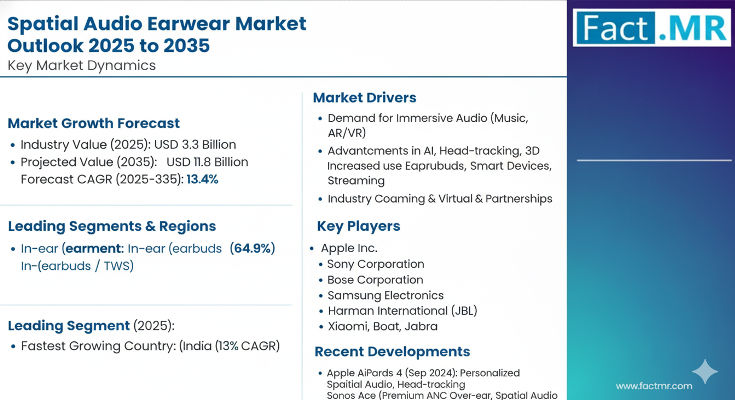The spatial audio earwear market is on track for robust expansion, driven by rising consumer demand for immersive audio experiences in everyday wearables. The industry is projected to grow at a compound annual growth rate (CAGR) of around 13.4% from 2025 to 2035. This strong growth reflects widespread adoption of earwear (earbuds, headphones, wearable audio devices) supporting spatial / 3D audio, head-tracking, and advanced sound rendering technologies that place sound in three-dimensional space around the user.
Market Drivers & Growth Catalysts
Several factors are fueling momentum in this market. As audio hardware becomes more sophisticated, consumers increasingly expect immersive, spatial sound not just in home or entertainment environments, but in portable / wearable formats. Earwear devices that can reproduce directional sound cues, spatial depth, and virtual surround sound environments are becoming more popular, especially with improved processing capabilities and integration of head-tracking sensors or algorithms. Wearable devices that support spatial audio are benefiting from higher content availability (music tracks, gaming audio, VR/AR applications) that leverage spatial / 3D audio formats.
Additionally, technological advancements in audio signal processing, headphone drivers, digital sound rendering, head-related transfer function (HRTF) algorithms, and low-latency wireless transmission are enabling earwear manufacturers to deliver convincing spatial audio inside a compact form factor. Because spatial audio enhances realism and immersion, earwear devices are being marketed not only for music / entertainment, but also for gaming, virtual / augmented reality, video calls, and immersive media.
Product Types & Application Segments
Spatial audio earwear includes true wireless earbuds, over-ear or on-ear headphones, neckband or in-ear wearables integrated with spatial audio processing chips / firmware. Devices vary in terms of features: some support dynamic head-tracking or motion sensors to adjust spatial audio in real time; others rely purely on fixed algorithms to simulate 3D audio. There are premium sequences of earwear offering higher fidelity spatial rendering, while mid-tier earbuds are increasingly adopting spatial / adaptive audio features at lower cost.
In terms of applications, beyond music listening, spatial audio earwear is used in immersive gaming or VR/AR headsets, video conferencing or virtual collaboration (where spatial sound enhances presence), as well as media consumption (movies, streamed content) or even hearing assistance / spatial orientation applications for accessibility.
Regional Outlook & Growth Opportunities
Growth is expected to be strong in regions with high consumer electronics adoption, particularly North America and Western Europe. These regions have large bases of audio technology enthusiasts and early adopters, plus mature streaming services and gaming / VR markets. Asia-Pacific is also likely to see fast growth, driven by rising disposable incomes, growing earwear / headphone demand, strong adoption of mobile and wearable electronics, and increasing gaming & media consumption. Emerging markets in Latin America, Middle East & Africa may follow as devices become more affordable and spatial audio features trickle down into mid-range earwear products.
Competitive Landscape & Strategic Trends
Earwear manufacturers, consumer electronics brands, and audio chip / DSP providers are competing to deliver spatial audio capabilities in compact earwear devices. Key areas of differentiation include spatial audio fidelity, low power consumption, head-tracking / motion sensors, wireless codec support, comfortable design with stable fit (important to maintain accurate spatial cues), and firmware / software updates to support new spatial formats. Partnerships between earwear hardware makers and content / audio processing platforms are also accelerating adoption, as content creators / streaming platforms support spatial or 3D audio formats specifically optimized for earwear.
Challenges & Market Restraints
Despite the promising outlook, there are challenges. Spatial audio in earwear demands precise calibration of audio signal and may suffer from sub-optimal fit or ear canal variations, affecting how spatial cues are perceived. Also, processing and wireless transmission must be low latency to maintain spatial accuracy, especially in VR/gaming applications. Battery life is a constraint, as extra processing and sensors (head-tracking, motion sensors) use additional power. Price sensitivity in mid or budget segments may slow adoption of premium spatial-capable earwear.
Forecast & Strategic Recommendations
With a forecast CAGR of 13.4% over 2025-2035, the market is clearly positioned for strong growth. Earwear manufacturers should invest in optimizing spatial audio algorithms for earbuds (compensating for individual ear shape or fit differences), reducing power consumption in spatial processing, and providing features like head-tracking or adaptive spatial audio. Expanding into emerging regions with more affordable spatial earwear models will help capture new consumer segments. Hardware + software optimization for wireless codecs and firmware upgrades will be key to differentiating offerings.
Browse Full Report: https://www.factmr.com/report/spatial-audio-earwear-market
Editorial Perspective
Spatial audio earwear is becoming a key premium differentiator in the crowded wearable audio space. As users demand more immersive, lifelike sound experiences on the go — whether for music, gaming, calls or virtual environments — earwear with true spatial audio capabilities will transition from niche high-end devices to mainstream features. Brands that can deliver consistent, low-latency, high-fidelity spatial sound in compact earbuds or headphones will lead the market over the next decade.


